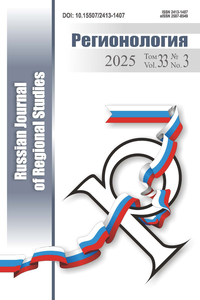M. Yu. Bareev, E. A. Samoilova. Development of Animal Rights Volunteer Movement: Regional Experience
M. Yu. Bareev, E. A. Samoilova. Development of Animal Rights Volunteer Movement: Regional Experience
Key words: region; animal rights volunteer movement; animal protection organization; mass communications; strong and weak ties theory; social network VKontakte
Introduction: the current stage of development of the Russian society is characterized by the expansion of self-organizing practices. The most common example of self-organization in the society is volunteering, which is a kind of social activity, contributing to the formation and development of civil society. Development of the animal rights volunteer movement has become one of the ways of manifestation of social activity and humanity towards animals. The animal protection movement is a relatively new and little-studied social phenomenon that requires a comprehensive analysis of its role and place in the structure of civil society, as well as of the composition and motivation of volunteers.
Materials and Methods: the article presents the materials of sociological research ‘Peculiarities of the Phenomenon of Animal Protection Volunteers in the Republic of Mordovia’ (2017) with the use of the case study research strategy. The following methods were used in the study: non-formalized (free) guide interview (plan, interview scenario), containing framework questions for discussion as well as analysis of cases of organizations.
Results: two animal protection organizations operating in the Republic of Mordovia, ‘Homeless Animals Aid Society’ and ‘Volunteer Help to Homeless Animals in the City of Saransk’, were identified and studied. ‘Homeless Animals Aid Society’ is at the stage of adoption and practical application of the existing rules and regulations enshrined in the Charter of the organization, i. e. it is at the stage of actual social practice. The other group, despite a large number of its members, is at the stage of forming social norms and rules in the course of spontaneous social interaction. There are about 8,000 members in the voluntary animal rights protection groups. The study made it possible to identify and describe several factors that had encouraged the respondents to become animal rights activists.
Discussion and Conclusions: the main factors of formation animal rights volunteer movement are the following: the initiative one, social networks, information and communication one, and empathic participation. At the same time, the initiative factor is the dominant one as it was mentioned by the majority of respondents. As recommendations for the promotion of animal rights volunteer movement the authors suggest a more active use of such communication channels as social advertising on regional TV, creating a YouTube channel on the Internet, proliferation of advertisements about animal protection organizations in social networks, which would contribute to a qualitative change in relation to animal rights volunteer movement activities in the public consciousness and could attract more people to the animal protection volunteer activities.
REFERENCES
1. Borovik M.A., Mikhel D.V. [Animal Protection Movement: History, Policies, Practice]. Zhurnal issledovanij social’noj politiki = The Journal of Social Policy Studies. 2010; 8:227—252. Available at: https://cyberleninka.ru/article/v/dvizheniya-po-zaschite-zhivotnyh-istor... (accessed 17.06.2017). (In Russ.)
2. Levchenko N.V. [Russian Animal Protectors: Who are They and How They Act?]. Sotsiologicheskie Issledovaniia = Sociological Studies. 2015; 2:151—155. Available at: http://socis.isras.ru/files/File/2015/2015_2/Levchenko.pdf (accessed 17.06.2017) (In Russ.)
3. Granovetter M. The Strength of Weak Ties: a Network Theory Revisited. Sociological Theory. 1983; 1:201—233. Available at: http://www.soc.ucsb.edu/faculty/friedkin/Syllabi/Soc148/Granovetter%2019... (accessed 17.03.2017).
4. Aybazova F.U. [Olunteering as a Channel of Civil Initiatives at Regional Level]. Kaspijskij region: politika, jekonomika, kul’tura = The Caspian Region: Politics, Economics, Culture. 2012; 4:106—110. Available at: http://kaspy.asu.edu.ru/files/4(33)/106-111.pdf (accessed 17.03.2017). (In Russ.)
5. Holina O.I. [Volunteering as Social Phenomenon of Modern Russian Society]. Teorija i praktika obshhestvennogo razvitija = Theory and Practice of Social Development. 2011; 8:71—73. Available at: https://cyberleninka.ru/article/v/volonterstvo-kak-sotsialnyy-fenomen-so... (accessed 17.03.2017). (In Russ.)
6. Rybalko V.A. [Global Experience in Solving Problems of Homeless Animals]. Veterinarnaya Patologiya = Veterinary Pathology. 2006; 2:12—19. Available at: http://vetpat.ru/wp-content/uploads/2014/03/Vet_patologija_02_06.pdf (accessed 17.03.2017). (In Russ.)
Contribution of the authors:
Maxim Yu. Bareev — statement of the scientific problem of the article and identification of the main ways to solve it, determination of the theoretical and methodological foundations of the research, writing the article.
Elena A. Samoylova — implementation of practical applications of the research results, revision of the article.
About the authors:
Maxim Yu. Bareev, Candidate of Sociological Sciences, Associate Professor at the Department of Sociology, National Research Mordovia State University (68 Bolshevistskaya St., Saransk, 430005, Russia) (е-mail: bareevmaksim@rambler.ru). ORCID: http://orcid.org/0000-0002-6228-100X.
Elena A. Samoilova, Student Pursuing a Master’s Degree at the Department of Sociology, National Research Mordovia State University (68 Bolshevistskaya St., Saransk, 430005, Russia) (е-mail: lenasamoilova199612@gmail.com). ORCID: http://orcid.org/0000-0002-5393-6027.
For citation: Bareev M.Yu., Samoilova E.A. Development of Animal Rights Volunteer Movement: Regional Experience. REGIONOLOGIYA = REGIONO-LOGY. 2018; 1(26):141—154. DOI: 10.15507/2413-1407.102.026.201801.141-154

All the materials of the "REGIONOLOGY" journal are available under Creative Commons «Attribution» 4.0
















